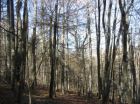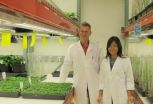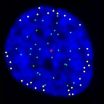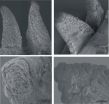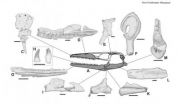University of Alberta research working towards treatment for aortic aneurysms in the abdomen
2012-12-20
(Press-News.org) A researcher with the Faculty of Medicine & Dentistry and the Mazankowski Alberta Heart Institute is looking closely at a molecule linked to aortic aneurysms in the abdomen, and her findings could lead to a treatment to reduce swelling of the aortic artery, which would be a life-saving treatment.
Zamaneh Kassiri, a professor in the Department of Physiology, and Ratnadeep Basu, a PhD trainee in Kassiri's lab, have been looking at the role of a protein called TIMP3 in the vessels. Their most recent findings, published in The Journal of Biological Chemistry, shows that animal models that lacked TIMP3 developed abdominal aneurysms. TIMP3 inhibits a family of proteins that normally chew up the structural proteins in the aortic wall and this role of TIMP3 has turned out to be critical in preventing swelling of the aortic aneurysm.
"This means if we can find a way to boost TIMP3 in the area, aneurysms could be avoided," said Kassiri.
The researchers dug even further in the lab, looking at another molecule called MMP2, which is well known as a contributor to heart and vascular disease. In models that lacked TIMP3, their level of MMP2 was quite high. The thought was that if the researchers lower the level of MMP2, the swollen aorta would be rescued.
However, that wasn't the case.
"The swelling became even larger," said Kassiri. "It is one of the bad guys, so everyone thought it was contributing to the disease, but likely is not, at least in this setting. MMP2 knockouts [lab models stripped of MMP2] alone didn't develop aneurysm; it's a combination of TIMP3 and MMP2 deficiency that made it worse."
Since last year the researchers have been looking at why this current model, which lacks both TIMP3 and MMP2, called a "double knockout," was so much worse. The group's research shows that the double knockout triggers the inflammation response in the aortic artery, which eventually produces another MMP molecule, this one being MMP9. It is responsible for reducing the elasticity of the artery, which means it can expand to let blood through, but it doesn't snap back to its original form.
From this discovery, the group decided to treat these double knockouts with MMP inhibitors and they were able to save the models from deadly aneurysm.
"If you detect aneurysms at a very early stage, when it's still small bulging in the abdomen, you can put the patient on MMP inhibitors and control the expansion," said Kassiri. "Whereas if you don't, [the aneurysm is] going to expand and may even rupture."
MMP inhibitors could be a good treatment, for now, as many are already approved drugs, such as doxycyclin). But the research group's goal is to develop a targeted therapy to enrich the swollen aorta with TIMP3.
"What we would want to do in the long term is to deliver TIMP3 locally," said Kassiri. "That's a challenging task considering the location of the aorta behind the abdominal area."
###
Kassiri's research is funded by the Heart & Stroke Foundation of Canada. Basu is supported by Alberta Innovates Health Solutions Graduate Studentship.
ELSE PRESS RELEASES FROM THIS DATE:
Death of hemlock trees yields new life for hardwood trees, but at what cost to the ecosystem?
2012-12-20
URBANA – Due to the introduction of exotic pests and pathogens, tree species are being eliminated one by one from forest ecosystems. In some cases, scientists can observe immediately how their loss affects the environment, whereas in other cases, creative puzzle solving and analysis reveal unexpected repercussions. In the case of the loss of the hemlock tree, University of Illinois landscape and ecosystem ecologist Jennifer Fraterrigo uncovered a surprising benefit to hardwood species.
Throughout much of the eastern United States, a pest called the hemlock woolly adelgid ...
Discovery may pave way to genetically enhanced biofuel crops
2012-12-20
Best known for its ability to transform simmering pots of sugared fruit into marmalades and jams, pectin is a major constituent of plant cell walls and the middle lamella, the sticky layer that glues neighboring plant cells together. Pectin imparts strength and elasticity to the plant and forms a protective barrier against the environment. Several different kinds of pectic compounds combine to form pectin. The relative proportion of each of these depends on the plant species, location within the plant, and environment. Pectic compounds decorated with β-1,4-galactan ...
Chromosome 'anchors' organize DNA during cell division
2012-12-20
LA JOLLA, CA----For humans to grow and to replace and heal damaged tissues, the body's cells must continually reproduce, a process known as "cell division," by which one cell becomes two, two become four, and so on. A key question of biomedical research is how chromosomes, which are duplicated during cell division so that each daughter cell receives an exact copy of a person's genome, are arranged during this process.
Now, scientists at the Salk Institute have discovered a new characteristic of human cell division that may help explain how our DNA is organized in the ...
From farm to table, mealworms may be the next best food
2012-12-20
Food enthusiasts interested in sustainable farm practices may soon have a new meat alternative: insects. Beetle larvae (called mealworms) farms produce more edible protein than traditional farms for chicken, pork, beef or milk, for the same amount of land used, according to research published December 19 in the open-access journal PLOS ONE by Dennis Oonincx and colleagues from the University of Wageningen, Netherlands.
The researchers compared the environmental impact of meat production on a mealworm farm to traditional animal farms using three parameters: Land usage, ...
Human history preserved in tree rings of prehistoric wooden wells
2012-12-20
Prehistoric farming communities in Europe constructed water wells out of oak timbers, revealing that these first farmers were skilled carpenters long before metal was discovered or used for tools. The research published December 19 in the open access journal PLOS ONE by Willy Tegel and colleagues from the University of Freiburg, Germany, contradicts the common belief that metal tools were required to make complex wooden structures.
The wooden water wells discovered in eastern Germany are over 7000 years old, and suggest that these early farmers had unexpectedly refined ...
Lizard tails detach at a biological 'dotted line'
2012-12-20
Like sheets of paper marked with perforated lines, gecko tails have unique structural marks that help them sever their tails to make a quick getaway. Though voluntarily shedding a body part in this manner is a well-known phenomenon, research published December 19 in the open access journal PLOS ONE reveals aspects of the process that may have applications for structural engineers making similar, quickly detachable structures.
VIDEO:
Bridging structures are not present between ...
Music with dinner: Whales sing during foraging season, not just while breeding
2012-12-20
Humpback whales might be expected to take their food seriously given their enormous size, but a new study shows that they may multi-task as they eat, singing mating or breeding songs as they forage in their Antarctic feeding grounds. The research, published December 19 in the open-access journal PLOS ONE by Alison Stimpert from the Naval Postgraduate School and colleagues, sheds new light on the whales' singing habits in different seasons, which are still a mystery.
Whales sing most frequently during the breeding season but are known to sing on other occasions, such as ...
First freshwater mosasaur discovered
2012-12-20
A new mosasaur species discovered in Hungary is the first known example of this group of scaled reptiles to have lived in freshwater river environments similar to modern freshwater dolphins, according to research published December 19 in the open-access journal PLOS ONE by Laszlo Makadi from the Hungarian Natural History Museum, Hungary and colleagues from the University of Alberta, Canada and MTA-ELTE Lendület Dinosaur Research Group, Hungary.
The species lived about 84 million years ago, the largest specimens reached about 20 feet in length, and belongs to a family ...
Transplanted neural stem cells treat ALS in mouse model
2012-12-20
LA JOLLA, Calif., December 19, 2012 – Amyotrophic lateral sclerosis (ALS), also known as Lou Gehrig's disease, is untreatable and fatal. Nerve cells in the spinal cord die, eventually taking away a person's ability to move or even breathe. A consortium of ALS researchers at multiple institutions, including Sanford-Burnham Medical Research Institute, Brigham and Women's Hospital, and the University of Massachusetts Medical School, tested transplanted neural stem cells as a treatment for the disease. In 11 independent studies, they found that transplanting neural stem cells ...
Unraveling the threads: Simplest cotton genome offers clues for fiber improvements
2012-12-20
From the stockings decorating mantles to the new outfits in display windows calling to shoppers, cotton is woven into the fabric of the holiday season. For bioenergy researchers, however, fiber composition matters more than color and texture as each cotton strand is composed of more than two dozen coils of cellulose, a target biomass for next-generation biofuels.
In the December 20, 2012 edition of Nature, an international consortium of researchers from 31 institutions including a team from the U.S. Department of Energy Joint Genome Institute (DOE JGI) present a high-quality ...
